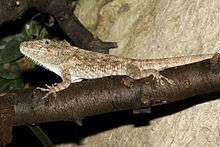Anolis barbatus
Anolis barbatus (western bearded anole) is a species of anole lizard from Western Cuba.[1] Adults have an average snout–vent length length of about 15 cm (6 in) with little sexual dimorphism.[2] i It is one of six species called "false chameleons" that sometimes are recognized as their own genus Chamaeleolis or as the Cuban clade in Xiphosurus.[3] These are all native to Cuba, fairly large for anoles, have robust heads, are dull gray-brown in color, have blunt teeth used for crushing snails and insects, which are their main diet.[4][5] Unusually among anoles, these all lack the ability to autotomize their tails.[3] Together with the similar (in appearance and microhabitat), but not closely related A. landestoyi of Hispaniola, they form a group known as the twig–giant ecomorph.[6]
| Western bearded anole | |
|---|---|
 | |
| Scientific classification | |
| Kingdom: | Animalia |
| Phylum: | Chordata |
| Class: | Reptilia |
| Order: | Squamata |
| Suborder: | Iguania |
| Family: | Dactyloidae |
| Genus: | Anolis |
| Species: | A. barbatus |
| Binomial name | |
| Anolis barbatus Garrido, 1982 | |
| Synonyms | |
| |
The length of many lizards toes and limbs can often tell where specific lizards spend their time. In False Chameleons, they have long limbs with extended toes on each foot that aids in climbing wide large trees much like iguanas. Iguanas are known for having a third eye. This eye aura evolved not for sight but to detect fluctuations in light. Bearded anoles also contain this eye. Third eyes play a major role in escaping predators like birds flying above the trees. While the bearded anole is focused on the ground to evade most predators, that third eye can detect when a bird flies over them. They have hooked claws to help with grip and to accelerate climbing. Thanks to their ability to camouflage they are able to blend in to the environment to hide from predators and to help them hunt . Bearded anoles help maintain insect populations, preventing over infestation as well as many dangerous diseases from spreading in both the environment and people. These stealthy creatures also contain toe pads much like those found in geckos. This allows them to jump run or hide on just about any surface. This animal has been thought to be slow-moving like chameleons while this is true when it comes to hiding from the eyes of predators, they are very quick creatures when it comes to feeding and running from predators if spotted.
See also
References
- Hedges, B. (30 May 2017). "Cuba". CaribHerp. Retrieved 30 March 2018.
- Scharf, I.; Meiri, S. (2013). "Sexual dimorphism of heads and abdomens: Different approaches to 'being large' in female and male lizards". Biological Journal of the Linnean Society. 110 (3): 665–673. doi:10.1111/bij.12147.
- Kristen A. Nicholson; Brian I. Crother; Craig Guyer; Jay M. Savage (10 September 2012). "It is time for a new classification of anoles (Squamata: Dactyloidae)" (PDF). Zootaxa. 3477: 1–108. doi:10.11646/zootaxa.3477.1.1.
- Holáňová Rehák, Frynta (2012). "Anolis sierramaestrae sp. nov. (Squamata: Polychrotidae) of the "chamaeleolis" species group from Eastern Cuba". Acta Soc. Zool. Bohem. 76: 45–52.
- Herrel , Holáňová (2008). "Cranial morphology and bite force in Chamaeleolis lizards – Adaptations to molluscivory?". Zoology. 111: 467–475. doi:10.1016/j.zool.2008.01.002. PMID 18674893.
- Mahler; Lambert; Geneva; Ng; Hedges; Losos; Glor (2016). "Discovery of a Giant Chameleon-Like Lizard (Anolis) on Hispaniola and Its Significance to Understanding Replicated Adaptive Radiations". Am. Nat. 188 (3): 357–364. doi:10.1086/687566. hdl:1808/25316. PMID 27501092.
| Wikimedia Commons has media related to Anolis barbatus. |